Japanese Table Manners
Japanese traditionally eat sitting on cushion placed on tatami floor. They seat around a low table. In formal situations both male and female are kneeling (“seiza”). In casual situations men sit cross-legged and women sit with both legs to one side.
The most important person present at meal seats on “kamiza” or the seat of honour. The kamiza is placed farthest from the entrance to the room where the meal is held.
If there is tokonoma in the room guest sits in front of it. Tokonoma (“toko” means "floor" or "bed", “ma” means "space" or "room.") is a built-in recessed space in traditional Japanese room. In English the word alcove is usually used. Some objects like calligraphic scrolls, pictorial scrolls and flower arrangements are kept in Tokonoma.
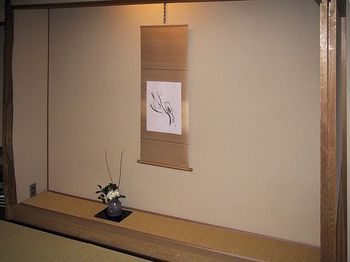 Tokonoma (alcove)
Tokonoma (alcove)
In restautrants and bars oshibori (a hot steamed towel) is offered to those present to clean their hands. At home it expected that people wash their hands before starting a meal.
The meal begins after the main guest, one family member or a waitress makes a gesture or tells those present to start eating.
Before starting a meal person says "itadakimasu" ("I gratefully receive"). After the meal is finshed you suppose to say "gochisosama (deshita)" ("Thank you for the meal").
Many of traditions concerning table manners are those about chopsticks. Chopsticks are two sticks of same length used as eating utensils in Japan, but also in some other Asian countries like China, Korea and Vietnam. Usually they are made of bamboo or plastic. Chopsticks made of metal, bone, ivory and different wood exist too.
The word chopsticks used in English language actually came from Chinese Pidgin English. There term “chow chow” meant quickly. In Japanese language chopsticks are called “hashi” or “otemoto”. Word otemoto means “right in your hand”. In this context “moto” is a base or foundation.
How to use chopsticks? Hold them in one hand, between the thumb and fingers, and use them to pick up pieces of food. Like everything in life it takes practice.
Never ever leave chopsticks standing vertically in the bowl of food. That way it looks quite similar to the offering made for one's ancestors.
When there is a dish, like for example salad, served in one bowl for everyone at the meal it is acceptable to reverse your chopsticks and use them that way. This is done mainly for hygienic purpose to prevent contact of the dish contents with something one has used for eating. The mentioned procedure exists only when there is no “toribashi” or “pickup chopsticks” that are provided as common utensil for everyone present at the meal.
When holding a bowl, a glass or any other object containing food or drink women should put their hand beneath it. Men should do it out of courtesy at a formal meal that includes senior or superior person.
Generally speaking soup is drunk by putting the bowl towards your mouth. Spoons are never used. Due to the fact that almost all soups in the Japanese cuisine have mass ingredient people use chopsticks when eating soup.
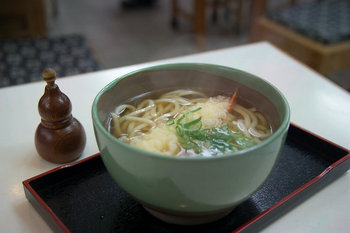 Udon noodles
Udon noodles
Soups with noodles are served in larger bowls. Do not be shy to slurp when eating noodles such as “udon”, “ramen” or “soba”. The Japanese think that it is perfectly ok. There is more. Japanese people believe that it is good to inhale the air when eating hot noodles. That way the taste of noodles is improved.
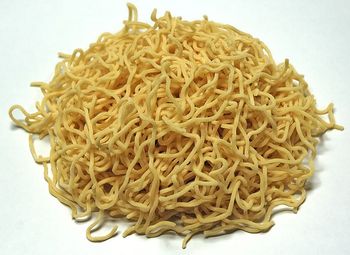 Ramen noodles
Ramen noodles
If, when eating, something falls on the table use “kaishi” or tissue paper to fold it. Leave everything by your side under the table. If there is no kaishi you can also use your chopsticks and put those pieces of food on the corner of your plate.
It is polite to finish all parts of meal at about same time. That means take a bite from one bowl, move to another and so on.
Taking a break during the meal is normal. What to do with you chopsticks? Just put them on a “hashioki” or chopstick stand. It can be a ceramic object or the one made of wood. For the same purpose you will sometimes get a halved cork.
It is not polite to use chopsticks when making gestures during meal. You should never transfer food from one chopsticks to another. Similar action exists in traditional Japanese funerals when separation of bones form ashes is done after the cremation.
Let's now mention thing or two about drinking. Imagine that you are pouring a wine or beer. The hand holding the bottle should pour forward. It is regarded an insult if the pouring is done backward.
Imagine that you are drinking some alcoholic beverage with several people. When you empty your glass you should put in front of you and wait for someone to fill it. If no one reacts you can just pour the drink yourself. What will then usually happen is an apology of one or more people present for not noticing that your glass is empty. You can just say no problem or which is even better say something witty like for example “my glass told me it is thirsty”.
Do not start to drink until everyone is served. When making a salute say “kampai”. Do not use term “chin chin”. Why? Well, in Japanese this term is used for male genitals.
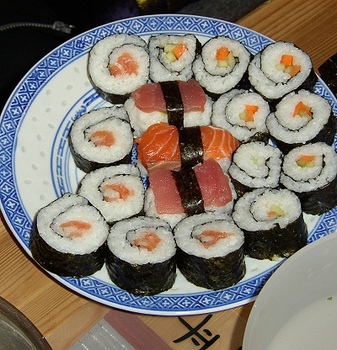 Sushi
Sushi
Let's end this article with several rules observed when eating sushi. Sushi is vinegar rice, usually topped with some other ingredients, like for example fish. You do not have to use chopsticks. Just grab sushi with your hands and eat it that way.
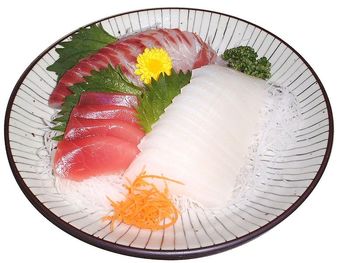 Sashimi
Sashimi
The exception to this rule is sashimi (pieces of raw fish). Sashimi is eaten with chopsticks. When possible finish your sushi in only one bite or hold it until you finish it. If you put unfinished sushi back on the plate it will be considered as something disgusting.
And yes, I should not forget it, when paying a bill in Japanese restaurant you do not have to leave a tip.